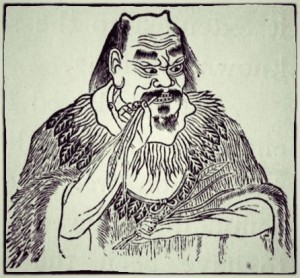
Cool, Acrid herbs that Release the Exterior
Menthae haplocalycis Herba is officially listed in the Chinese Pharmacopoeia as the dried aerial part of Mentha haplocalyx Briq. (Fam. Labiatae). This herb is used for fever due to exogenous pathogenic factors, headache during influenza, upper respiratory infection and the initial stages of other epidemic febrile diseases.
Taste: Acrid, Aromatic Temperature: Cool Channels: Lung, LiverDosage: 3-6g (2-10g); Generally added during the last 5-10 minutes of decoction. To soothe Liver qi, boil with the whole decoction.
Key Characteristics:
- Disperses Wind-Heat
- Clears head and eyes
- Benefits the throat
- Promotes skin eruption
- Soothes the Liver
Cautions & Contraindications:
- Can deplete the qi: should not be used in debilitated patients who sweat profusely or those with ascendant Liver yang.
- Releases the exterior and disperses wind-heat: for initial stages of wind-heat, with symptoms such as headache, fever, the absence of perspiration, dry mouth, and sore throat.
- Clears the head, brightens the eyes, and benefits the throat: for wind-heat in the upper body, with disorders of the throat and head, such as headache, sore throat, and red eyes.
- Vents rashes: used in the early stages of rashes to induce to come to the surface as a means of venting the wind and heat, thereby speeding recovery.
- Expels turbid filth: for problems such as summertime exposure to unclean qi leading to summerheat gastric disturbance, with abdominal pain, vomiting, diarrhea, and a thick, greasy yellow tongue coating (Damp-heat in the Middle Jiao).
- Soothes and relieves Liver qi stagnation: relieves discomfort, distention, and pain in the chest and hypochondrium.
Combinations:
- Ju Hua: itchy irritated eyes with an external invasion.
- Ju Hua, Niu Bang Zi, Gan Cao: red eyes due to wind-heat.
- Jing Jie, Jie Geng, Sang Ye, Ju Hua, Niu Bang Zi: wind-heat invasion.
- Chan Tui, Shi Gao, Gan Cao: early stage febrile disease.
- Zi Su Ye, Fang Feng, Qiang Huo: wind-cold.
- Niu Bang Zi, Ban Lan Gen, She Gan: sore throat due to wind-heat.
- Liang Qiao, Jie Geng, Gu Zhi Hua: sore throat with loss of voice.
- Chai Hu: to relieve Liver constraint.
- Chai Hu, Bai Shao, Dang Gui: Liver qi stagnation.
- Ju Hua, Sang Ye: red eyes, blurred vision, headache, and hypertension due to Liver yang rising.
- Jing Jie, Niu Bang Zi, Lian Qiao: measles (promotes eruption).
- Chang Tui, Jing Jie, Di Fu Zi, Niu Bang Zi: rash, eczema, or general itching.
- Jie Geng: acute mastitis (topically, 2x/day).
- Huo Xiang, Lian Qiao, Bai Dou Kou: vomiting and diarrhea due to summerheat and dampness.
Formulas:
- Sang Ju Yin: wind-heat
- Yin Qiao San: wind-heat
- Xiao Yao San: Liver qi stagnation
- Gan Lu Xiao Du Dan: summerheat and dampness
- Cang Er Zi San
Commentary:
- Bo He has a light, floating, and ascending nature, which allows it to rise to the head, eyes, and surface of the body.
- Most strongly addresses the eyes, head, throat, and abdomen.
- It can also be used to treat wind-cold when combined with warm, acrid herbs.
- Turbid filth in the Middle Jiao can be due to summerheat, or damp-heat. This can be due to excess or spoiled foods.
Western Medical Indications: fever due to exogenous pathogenic factors, headaches, hyperemia, conjunctivitus, pharyngolaryngitis, sore throat, oral and dermal lesions, rash, toothache, rubella measles.
Pharmacological:
- Increases local blood circulation when applied topically.
- Antipyretic
- Diaphoretic: Orally administered in small amounts M. Haplocalycis dilated the cutaneous capillary vessels through stimulation of the CNS. This effect promotes perspiration and heat dissipation.
- Anti-inflammatory
- Anti-bacterial and anti-viral: M. Haplocalycis was proved in vitro to be effective against Staphylococcus aureus, Staphylococcus alba, Alpha streptococcus, Beta streptococcus, Neisseria catharrhalis, Neisseria enteritidis, Shigella flexneri, Bacillus anthracis, Corynebacterium dipheteriae, Salmonella typhi, Pseudomonas aeruginosa, Escherichia coli, Proteus vulgaris and Candida albicans.
- In vitro, the infusion of M. Haplocalycis inhibited human cervical cancer JTC-26 strain.
Chemical Constituents: The main chemical constituents contained in Bo He are volatile oil which mainly contains 8 isomers of menthol (mentha camphor), followed by menthone and isomenthone. M. Haplocalycis also contains menthenone, camphene, pinene, limonene, rosmarinic acid, and azulen.


